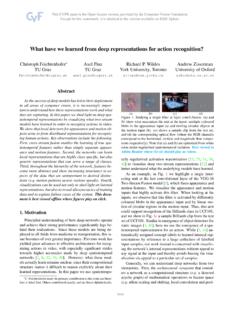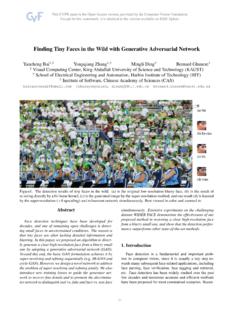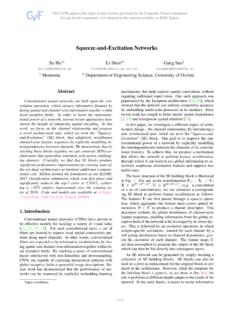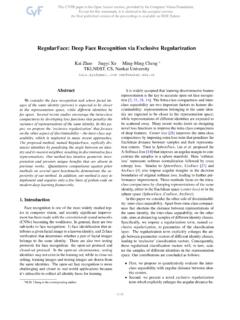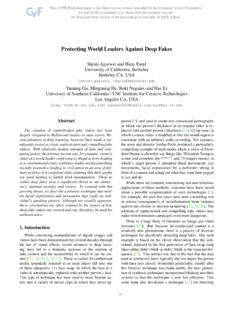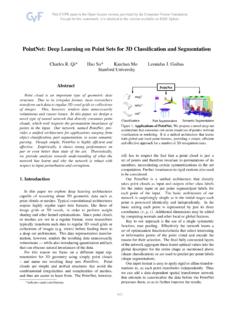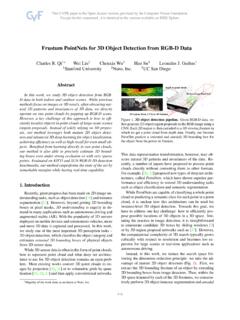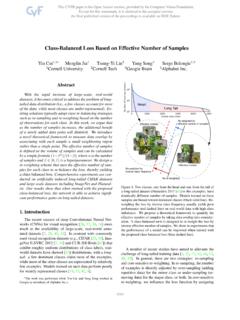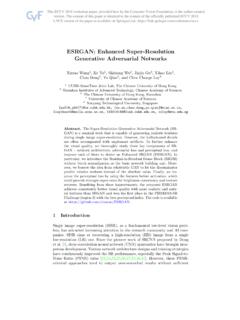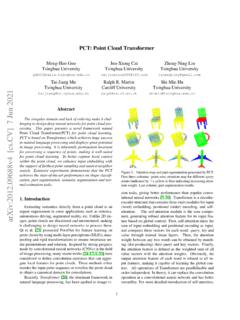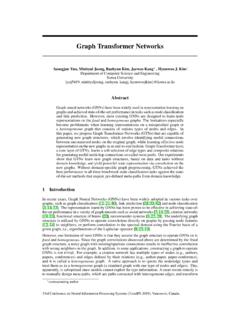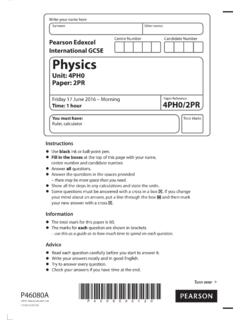Transcription of Diverse Part Discovery: Occluded Person Re-Identification ...
1 2898. extra semantic based methods [13, 30, 40, 5, 11] directly similar appearances. In this way, we can obtain the pixel utilize human parsing [13, 11] or pose estimation mod- context aware feature map, which is more robust to back- els [30, 40, 5] as part localization modules to achieve more ground clutters. In the part prototype based transformer accurate human part localization. However, their success decoder, we introduce a set of learnable part prototypes to heavily relies on the accuracy of the off-the-shelf human generate part-aware masks focusing on discriminative hu- parsing or pose estimation models. Since there exist dif- man parts. In specific, given the feature map of a pedestrian, ferences between training datasets of human parsing/pose we take the learnable part prototypes as queries and pixels estimation and Person Re-ID, the off-the-shelf human pars- of the feature map as keys and values of the transformer ing/pose estimation models are error-prone when pedestri- decoder.
2 We can obtain part-aware masks by calculating ans are seriously Occluded . (3) The attention based meth- the similarity between all pixels in the feature map and part ods [37, 62] exploit attention mechanisms to localize dis- prototypes. Each part-aware mask is expected to denote the criminative human parts. Typically, the predicted attention spatial distribution of one specific human part, , head or maps distribute most of the attention weights on human body part. With part-aware masks, human part features can parts, which can help decrease the negative effect of clut- be further obtained from the values by a weighted pooling. tered background. To sum up, most existing Occluded Re- However, without the assistance of part annotations, it is ID methods focus on locating discriminative human parts challenging to constraint these part prototypes to capture ac- and leveraging local part features to develop powerful rep- curate human parts. Thus, to guide part prototype learning, resentations of the pedestrian.
3 We propose two mechanisms including part diversity and Based on the above discussions, the part-based represen- part discriminability. Intuitively, different part features of tations have been proven to be effective for the Occluded the same pedestrian should focus on different human parts. Re-ID problem. To capture accurate human parts, an intu- Therefore, the part diversity mechanism is adopted to en- itive idea is to detect non- Occluded body parts using body courage lower correlation between part features and make part detectors and then match the corresponding body parts. part prototypes focus on different discriminative foreground However, there are no extra annotations for the body de- regions. The part discriminability mechanism is to make tector learning. Thus, we propose to localize discrimina- part features maintain identity discriminative via part clas- tive human parts only with identity labels. To achieve this sification and a triplet loss. By optimizing the transformer goal, there are two main challenges as follows.
4 On the one encoder and decoder jointly, part prototypes can be learned hand, background with Diverse characteristics, such as col- through the whole dataset. Consequently, we can achieve ors, sizes, shapes, and positions, increase the difficulty of robust human part discovery for Occluded Person Re-ID in getting robust features for the target Person . Intuitively, a weakly supervised manner. the appearance of pixels of the same human part region is The contributions of our method could be summarized similar, while quite different from the background pixels. into three-fold: (1) We propose a novel end-to-end Part- Therefore, it is necessary to model the correlation between Aware Transformer for Occluded Person Re-ID through di- pixels for robust feature representation. On the other hand, verse part discovery via a transformer encoder-decoder ar- as shown in Figure 1, the Occluded parts vary between dif- chitecture, including a pixel context based transformer en- ferent pedestrian images.
5 As there are no groundtruth an- coder and a part prototype based transformer decoder. To notations for human parts, it is difficult to cope with Diverse the best of our knowledge, our PAT is the first work by appearance of pedestrians and adaptively locate all unoc- exploiting the transformer encoder-decoder architecture for cluded parts only with the identity labels. As a result, as Occluded Person Re-ID in a unified deep model. (2) To learn shown in Figure 1 (c), most of the attention based methods part prototypes only with identity labels well, we design two tend to put the main focus on the most discriminative re- effective mechanisms, including part diversity and part dis- gion. They always ignore other human parts including per- criminability. Consequently, we can achieve robust human sonal belongings, , backpack and reticule, which also part discovery for Occluded Person Re-ID in a weakly su- provide important clues for Person Re-ID. pervised manner. (3) To demonstrate the effectiveness of our method, we perform experiments on three tasks, includ- To deal with the above issues, we propose a novel ing Occluded Re-ID, partial Re-ID and holistic Re-ID on Part-Aware Transformer (PAT) for Occluded Person Re-ID.
6 Six standard Re-ID datasets. Extensive experimental results through Diverse part discovery via a transformer encoder- demonstrate that the proposed method performs favorably decoder architecture [39, 2], including a pixel context based against state-of-the-art methods. transformer encoder and a part prototype based transformer decoder. In the pixel context based transformer encoder, we adopt a self-attention mechanism to capture the full im- 2. Related Work age context information. Specifically, we model the corre- In this section, we briefly overview methods that are re- lation of pixels of the feature map and aggregate pixels with lated to holistic Person Re-ID, partial Re-ID and Occluded 2899. Person Re-ID respectively. guided Visible Part Matching (PVPM) model to learn dis- Holistic Person Re-Identification . Person Re-Identification criminative part features with pose-guided attentions. Wang (Re-ID) aims to match images of a Person captured from et al. [40] exploit graph convolutional layers to learn high- non-overlapping camera views [7, 44, 54].
7 Existing Re- order human part relations for robust alignment. Although ID methods can be summarized to hand-crafted descrip- the above methods can solve the occlusion problem to some tors [47, 23], metric learning methods [56, 20, 24] and deep extent, most of them heavily rely on off-the-shelf human learning methods[38, 25, 33, 35, 45, 52, 19, 21, 34, 26, 22]. parsing models or pose estimators. Different from them, Recent works utilizing part-based features have achieved our model can exploit Diverse parts with only identity labels state-of-the-art performance for the holistic Person Re-ID in a weakly supervised manner via a transformer encoder- task. Kalayeh et al. [19] extract several region parts with decoder architecture. human parsing methods and assemble final discriminative 3. Part-Aware Transformer representations with part-level features. Sun et al. [38] uni- formly partition the feature map and learn part-level fea- In this section, we introduce the proposed Part-Aware tures by multiple classifiers.
8 Zhao et al. [51] and Liu et Transformer (PAT) in detail. As shown in Figure 2, the pro- al. [26] extract part-level features by attention-based meth- posed PAT mainly consists of two modules, including the ods. But all these Re-ID methods focus on matching holis- pixel context based transformer encoder and the part proto- tic Person images with the assumption that the entire body type based transformer decoder. Here we give a brief intro- of the pedestrian is available. Different from these methods, duction to the full process. First, we obtain the feature map our model can adaptively capture discriminative human part of each pedestrian image through a CNN backbone. Then features via a transformer encoder-decoder architecture for we flatten the feature map and carry out the self-attention the Occluded Person Re-ID task. operation to obtain the pixel context aware feature map with the transformer encoder. After obtaining the pixel context Partial Person Re-Identification .
9 Partial Person Re-ID. aware feature map, we calculate the similarity between the aims to match partial probe images to holistic gallery im- feature map and a set of learnable part prototypes to obtain ages. Zheng et al. [57] propose a local-level match- part-aware masks. Part features can be further obtained by ing model called Ambiguity-sensitive Matching Classifier a weighted pooling where part-aware masks are treated as (AMC) based on the dictionary learning and introduce different spatial attention maps. Finally, we introduce the a local-to-global matching model called Sliding Window part diversity mechanism and part discriminability mecha- Matching to provide complementary spatial layout infor- nism to learn part prototypes well with only identity labels. mation. He et al. [10] propose an alignment-free approach namely Deep Spatial feature Reconsruction (DSR) that ex- Pixel Context based Transformer Encoder ploits the reconstruction error based on sparse coding.
10 Luo Background regions with Diverse characteristics increase et al. [29] proposed STNReID that combines a spa- the difficulty of getting robust features for the target Person . tial transformer network (STN) and a Re-ID network for Therefore, we adopt a self-attention mechanism to capture partial Re-ID. Sun et al. [37] introduce a Visibility-aware the full image context information. In this way, we can ob- Part Model (VPM) to perceive the visibility of part regions tain the pixel context aware feature map, which is more ro- through self-supervision. However, all these methods need bust to background clutters. Following [38], our method a manual crop of the Occluded target Person in the probe im- uses ResNet-50 [9] without the average pooling layer and age and then use the non- Occluded parts as the new query. fully connected layer as the backbone to extract global fea- The manual cropping is not efficient in practice and might ture maps from given images. We also set the stride of introduce human bias to the cropped results.
